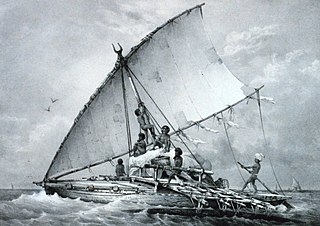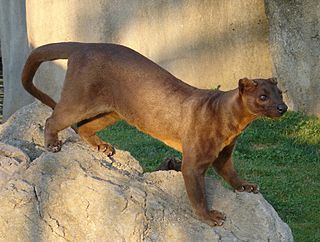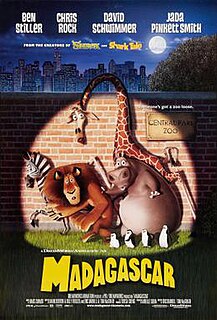
Madagascar, officially the Republic of Madagascar, and previously known as the Malagasy Republic, is an island country in the Indian Ocean, approximately 400 kilometres off the coast of East Africa across the Mozambique Channel. At 592,800 square kilometres (228,900 sq mi) Madagascar is the world's second-largest island country, after Indonesia. The nation consists of the island of Madagascar and numerous smaller peripheral islands. Following the prehistoric breakup of the supercontinent Gondwana, Madagascar split from the Indian subcontinent around 88 million years ago, allowing native plants and animals to evolve in relative isolation. Consequently, Madagascar is a biodiversity hotspot; over 90% of its wildlife is found nowhere else on Earth. The island's diverse ecosystems and unique wildlife are threatened by the encroachment of the rapidly growing human population and other environmental threats.

The Mozambique Channel is an arm of the Indian Ocean located between the Southeast African countries of Madagascar and Mozambique. The channel is about 1,600 km (1,000 mi) long and 419 km (260 mi) across at its narrowest point, and reaches a depth of 3,292 m (10,800 ft) about 230 km (143 mi) off the coast of Mozambique. A warm current, the Mozambique Current, flows in a southward direction in the channel, leading into the Agulhas Current off the east coast of Southern Africa.

Madagascar is a large island in the Indian Ocean off the eastern coast of southern Africa, east of Mozambique. It has a total area of 587,040 square kilometres (226,660 sq mi) with 581,540 square kilometres (224,530 sq mi) of land and 5,500 square kilometres (2,100 sq mi) of water. Madagascar is the fourth largest island and the 2nd largest island country in the world. The highest point is Maromokotro, in the Tsaratanana Massif region in the north of the island, at 2,876 metres (9,436 ft). The capital Antananarivo is in the Central Highlands near the centre of the island. It has the 25th largest Exclusive Economic Zone of 1,225,259 km2 (473,075 sq mi). Madagascar is 400 kilometres east of mainland Africa.

The history of Madagascar is distinguished clearly by the early isolation of the landmass from the ancient supercontinent containing Africa and India, and by the island's late colonization by human settlers from the Sunda islands and from East Africa. These two factors facilitated the evolution and survival of thousands of endemic plant and animal species, some of which have gone extinct or are currently threatened with extinction due to the government not allocating resources to help the growing population, causing many people to resort to harmful environmental practices as a way of survival. Trade in the Indian Ocean at the time of first colonization of Madagascar was dominated by large ships, called Djong, coming from Java and Sumatra.

Elephant birds are members of the extinct ratite family Aepyornithidae, made up of large to enormous flightless birds that once lived on the island of Madagascar. They became extinct, perhaps around 1000–1200 AD, probably as a result of human activity. Elephant birds comprised the genera Mullerornis, Vorombe and Aepyornis. While they were in close geographical proximity to the ostrich, their closest living relatives are kiwi, suggesting that ratites did not diversify by vicariance during the breakup of Gondwana but instead evolved from ancestors that dispersed more recently by flying.

Lemurs are wet-nosed primates of the superfamily Lemuroidea, divided into 8 families and consisting of 15 genera and around 100 existing species. They are native only to the island of Madagascar. Most existing lemurs are small, have a pointed snout, large eyes, and a long tail. They chiefly live in trees (arboreal), and are active at night (nocturnal).

The fossa is a carnivorous mammal that is endemic to Madagascar. It is a member of the Eupleridae, a family of carnivorans closely related to the mongoose family Herpestidae.

The Malagasy are an Austronesian ethnic group native to the island country of Madagascar.

Madagascar is divided into 23 regions (faritra). These formerly second-tier administrative divisions became first-level administrative divisions when the former six provinces were dissolved on 4 October 2009.

Districts are second-level administrative divisions of Madagascar below the regions. There are 114 districts in Madagascar. Districts are in their turn divided into communes; while some of the districts in urban areas and offshore islands each consist of only one commune, most of the districts are divided typically into 5–20 communes.

Madagascar is a 2005 American computer-animated comedy film produced by DreamWorks Animation and distributed by DreamWorks Pictures. It was directed by Eric Darnell and Tom McGrath and written by Mark Burton, Billy Frolick, Darnell, and McGrath. The film stars Ben Stiller, Chris Rock, David Schwimmer, and Jada Pinkett Smith, voicing a group of animals from the Central Park Zoo who find themselves stranded on the island of Madagascar.

The Penguins of Madagascar is an American CGI-animated television series co-produced by DreamWorks Animation and Nickelodeon. It stars nine characters from DreamWorks' animated film Madagascar: the penguins Skipper, Rico, Kowalski, and Private ; the lemurs King Julien, Maurice, and Mort ; and Mason and Phil the chimpanzees. Characters new to the series include Marlene the otter and a zookeeper named Alice. It is the first Nicktoon co-produced with DreamWorks Animation. The series was executive-produced by Bob Schooley and Mark McCorkle, who were the creators of the animated series Buzz Lightyear of Star Command and Disney Channel's Kim Possible.

Madagascar is an American computer-animated media franchise owned and produced by DreamWorks Animation. The voices of Ben Stiller, Chris Rock, David Schwimmer and Jada Pinkett Smith are featured in the films. It began with the 2005 film Madagascar, the 2008 sequel Madagascar: Escape 2 Africa and the third film Madagascar 3: Europe's Most Wanted in 2012. A spin off film featuring the penguins, titled Penguins of Madagascar, was released in 2014. A fourth film, Madagascar 4, was announced for 2018, but has since been removed from its schedule due to the studio's restructuring.

Madagascar 3: Europe's Most Wanted is a 2012 American computer-animated comedy film produced by DreamWorks Animation and distributed by Paramount Pictures. It is the third installment of the Madagascar film series, following Madagascar: Escape 2 Africa (2008), and was the first film in the series to be released in 3D. It was directed by Eric Darnell, Tom McGrath, and Conrad Vernon from a screenplay by Darnell and Noah Baumbach, and features Ben Stiller, Chris Rock, David Schwimmer, Jada Pinkett Smith, Sacha Baron Cohen, Cedric the Entertainer, and Andy Richter reprising their voice acting roles from the previous installments, alongside new cast members Jessica Chastain, Bryan Cranston, Martin Short, and Frances McDormand. In the film, the main characters—a party of animals from the Central Park Zoo whose adventures have already taken them to Madagascar and Africa—attempt to return to New York, and find themselves traveling across Europe with a circus while being pursued by a relentless Animal Control officer.

Malagasy is an Austronesian language and the national language of Madagascar. Malagasy is the westernmost Malayo-Polynesian language, brought to Madagascar by the settlement of Austronesian peoples from the Sunda islands around the 5th century AD. The Malagasy language is one of the Barito languages and is most closely related to the Ma'anyan language, still spoken on Borneo to this day. Malagasy also includes numerous Malay and Javanese loanwords, from the time of the early Austronesian settlement and trading between Madagascar and the Sunda Islands. After c. 1000 AD, Malagasy incorporated numerous Bantu and Arabic loanwords, brought over by new settlers and traders.
Ma'anyan or Ma'anjan or Maanyak Dayak is an Austronesian language belonging to the East Barito languages. It is spoken by about 150,000 Ma'anyan people living in the province of Central Kalimantan, Indonesia. It is closely related to the Malagasy language spoken in Madagascar.
Malagasia is a monotypic genus of trees in the family Proteaceae. The sole species is Malagasia alticola, endemic to Madagascar.

Dilobeia thouarsii is a species of tree in the family Proteaceae. It is endemic to Madagascar. The specific epithet honours French botanist Louis-Marie Aubert du Petit-Thouars. The leaves are used in traditional Malagasy medicine to treat wounds and bacterial skin infections.
Dilobeia tenuinervis is a species of tree in the family Proteaceae. It is endemic to Madagascar.
The Malagasy N1A is the top basketball league in Madagascar. Currently, twelve teams play in the competition to determine who is the national champion of Madagascar. The defending champion is GNBC.















